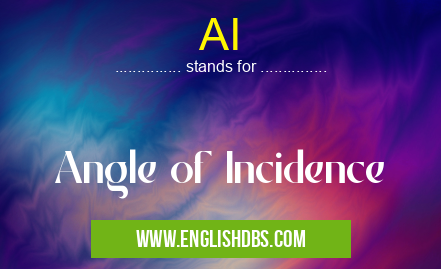What does AI mean in ARCHITECTURE
AI stands for Angle of Incidence, a crucial concept in optics. It refers to the angle at which a light ray strikes a surface or interface. Understanding AI is essential in various scientific fields, particularly in the study of light and its interactions with matter.

AI meaning in Architecture in Academic & Science
AI mostly used in an acronym Architecture in Category Academic & Science that means Angle of Incidence
Shorthand: AI,
Full Form: Angle of Incidence
For more information of "Angle of Incidence", see the section below.
Definition
- Angle of Incidence (AI): The angle formed between the incident light ray and the normal (a line perpendicular to the surface) at the point of incidence. AI is measured in degrees from 0° to 90°.
Key Concepts
- Normal: A line perpendicular to the surface at the point of incidence.
- Incident Ray: The incoming light ray that strikes the surface.
- Reflected Ray: The light ray that bounces off the surface.
- Refracted Ray: The light ray that passes through the surface, bending its path.
Importance of AI
AI plays a significant role in understanding various optical phenomena, including:
- Reflection: AI determines the angle at which light reflects off a surface.
- Refraction: AI influences the angle at which light bends when passing through an interface between two materials.
- Lenses: AI helps explain how lenses focus light rays.
- Optical Instruments: Understanding AI is crucial for designing and optimizing optical instruments such as telescopes, microscopes, and cameras.
Essential Questions and Answers on Angle of Incidence in "SCIENCE»ARCHITECTURE"
What is Angle of Incidence (AI)?
Angle of Incidence (AI) refers to the angle between an incoming ray of light and the normal (perpendicular) to a surface. It is a crucial concept in optics, determining the behavior of light when it interacts with various surfaces.
How is AI measured?
AI is typically measured in degrees (°) or radians. It is the angle between the incoming ray and the normal to the surface at the point of incidence. The normal is a straight line perpendicular to the surface at that point.
What happens to light when it strikes a surface with a specific AI?
The behavior of light depends on the AI and the properties of the surface. If the AI is less than the critical angle for the given surface, the light will undergo refraction (bending) as it enters the material. If the AI is greater than the critical angle, the light will undergo total internal reflection and be reflected back into the original medium.
How does AI affect the reflection and refraction of light?
AI determines the angle of reflection and the angle of refraction. The angle of reflection is equal to the AI, while the angle of refraction depends on both the AI and the refractive indices of the two materials involved. A higher AI generally results in a greater angle of refraction.
Why is AI important in optics?
AI is fundamental in understanding the behavior of light and designing optical systems. It is used in lenses, prisms, mirrors, and various optical instruments to control the direction and properties of light for imaging, focusing, and other applications.
Final Words: Angle of Incidence (AI) is a fundamental concept in optics that describes the angle at which light strikes a surface or interface. It is crucial in understanding light interactions, designing optical systems, and interpreting optical phenomena.
AI also stands for: |
|
| All stands for AI |
